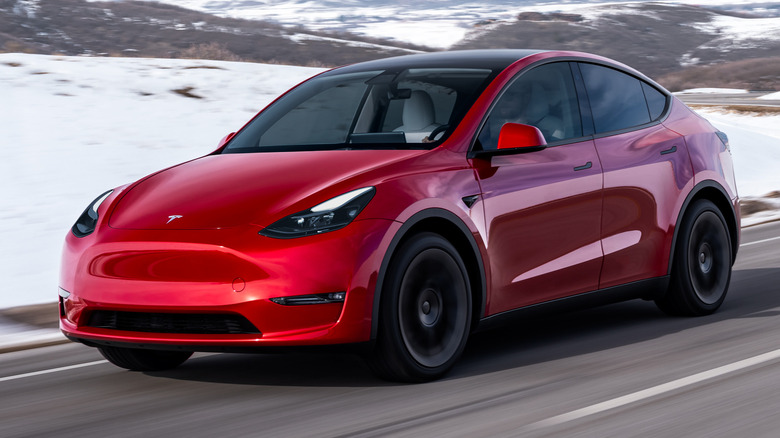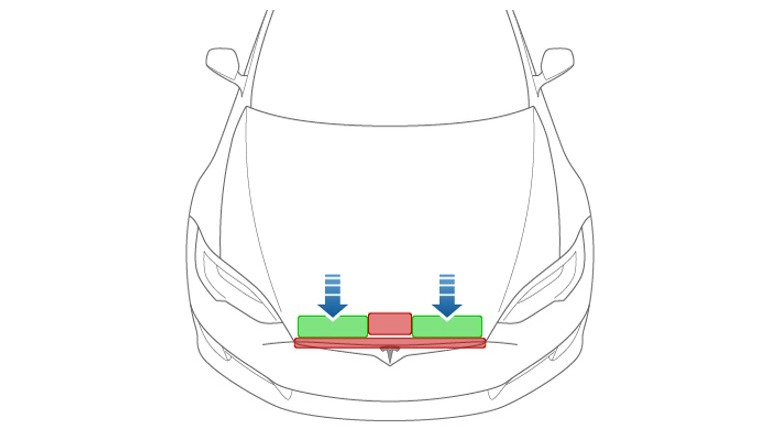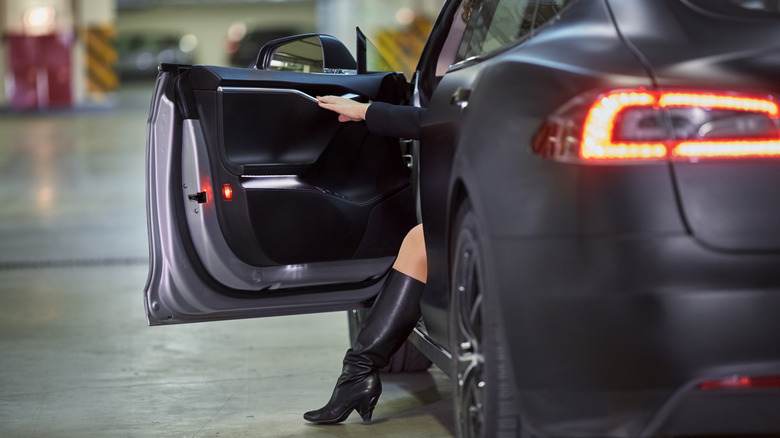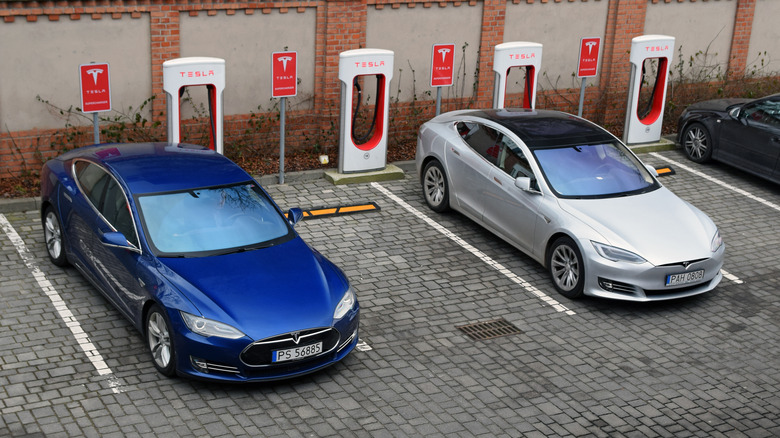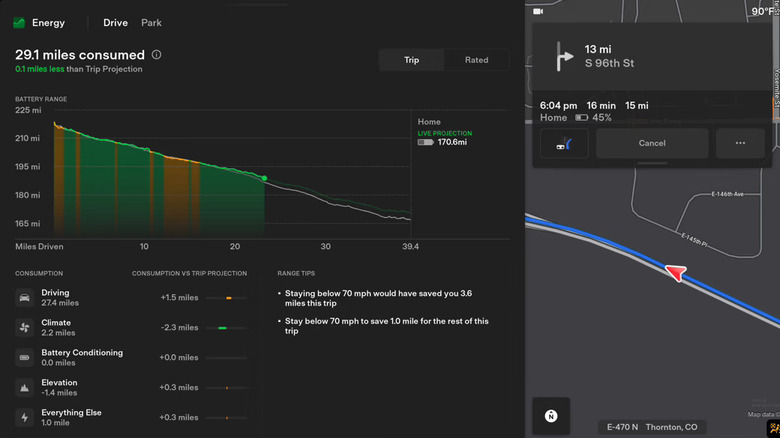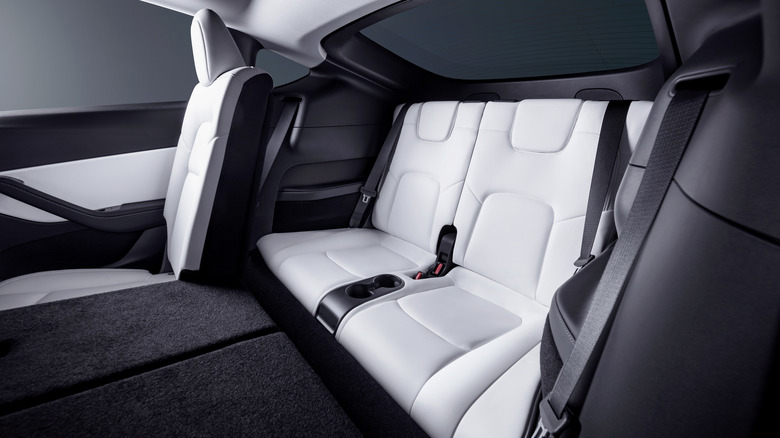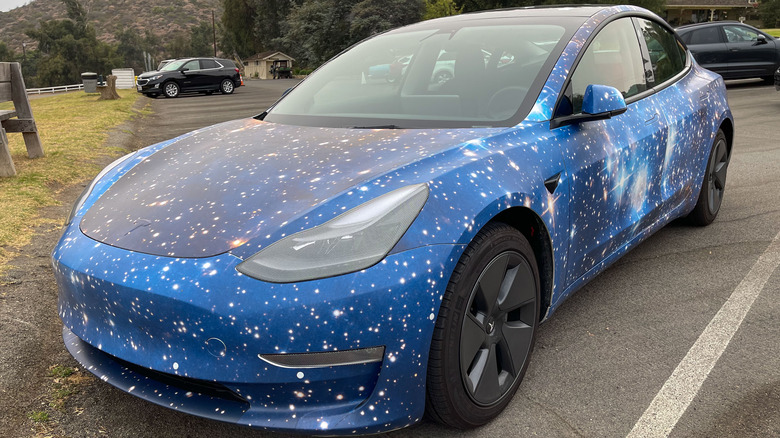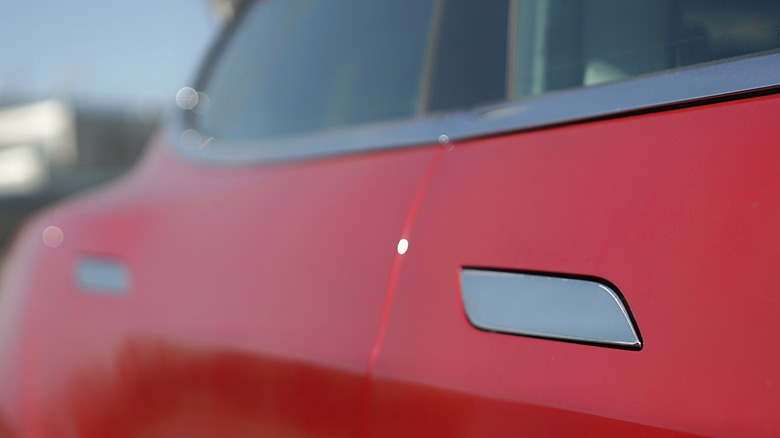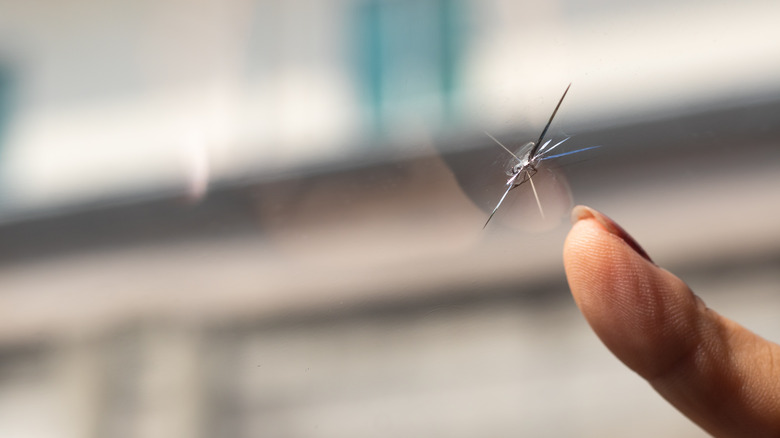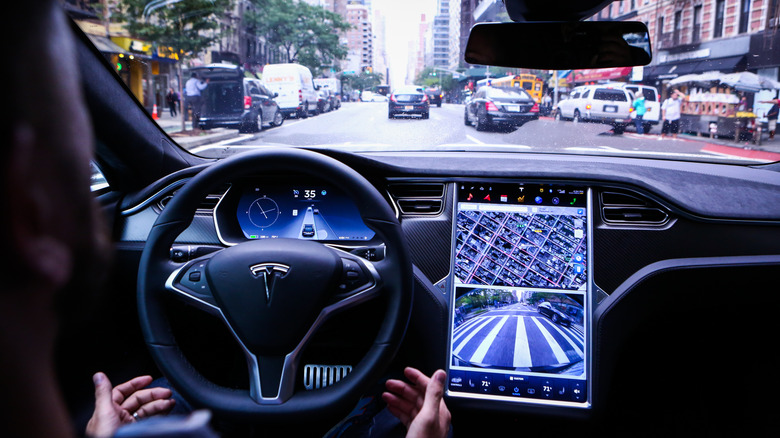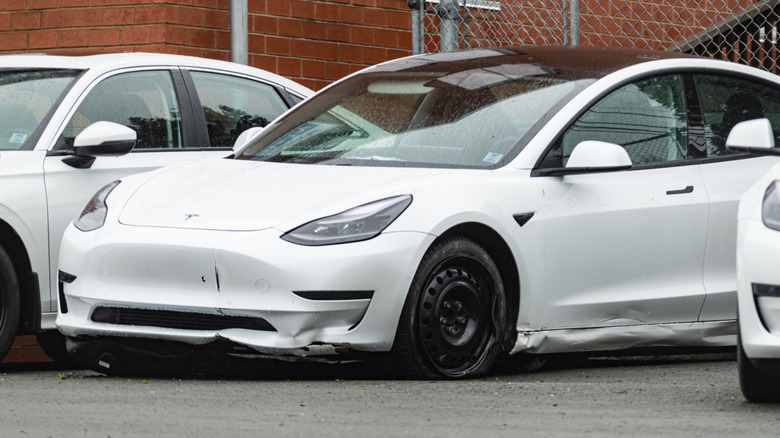Things You Should Stop Doing With Your Tesla Immediately
One of the key reasons that Teslas have exploded in popularity over the past few years is that driving one is a very different experience to driving any traditional car. They're packed with fun features and useful innovations that benefit from regular updates, and their designs remain distinctive even in an increasingly crowded field of EV competitors. However, these differences mean that anyone who's unfamiliar with the quirks of driving or being a passenger in a Tesla can unwittingly cause damage to their vehicle by doing simple things that might seem intuitive for any other, more traditional car.
Every Tesla model has its own distinct quirks that are best researched by looking through owners' forums or Tesla's user manual, but here we're only focusing on things that affect all models of Tesla to some degree. Some are only minor risks that, in a worst-case scenario, might cost a few hundred dollars at your local Tesla center to put right. Others could cause much more significant damage and result in a bigger dent in your wallet.
Don't slam the hood
Closing the hood of almost any gas-powered car requires some degree of force to "slam" it properly shut. Most owners will drop the hood a foot or two to close it, and then might apply some pressure to the area of the catch to ensure it's properly fastened. However, do this in a Tesla and you risk doing damage to your car. This is because Tesla's hoods are particularly light, and so can deform much more easily than those of most other cars. The correct method to close the hood on a Tesla is to lower it until the striker and latches are touching, then press down on specific areas to engage them.
These areas vary slightly between models, so it's worth consulting your owner's manual to ensure you're pressing down on the right area. The manual will show areas that are safe to apply pressure in green, while areas to avoid are highlighted in red. This is especially important for owners of the Model S and Model X, as they have smaller safe pressure areas, and are therefore the most susceptible to damage if you get it wrong. The Model 3 and Model Y are slightly less fussy, but it's still worth double-checking the user manual to make sure you don't accidentally cause any damage.
Don't use the manual door release
Another common mistake that's easy to make if you're used to traditional gas-powered cars is using the door release that's in front of the window switches to get out of the car. This switch manually unlocks the door, but because of the unique design of Tesla's doors and windows, it's not recommended for regular use. Instead, be sure to use the button located at the top of the handle, which lowers the window slightly before opening the door to ensure you don't catch it on the interior trim. Using the manual release switch won't ensure that the windows are appropriately lowered before the latch is unlocked, so there's a risk of catching them every time you open and close the door.
The manual switch is only designed for use in an emergency, in case the Tesla loses power and can't be unlocked through the normal button. As well as catching out new Tesla drivers, this can often catch out passengers who aren't familiar with the brand's design quirks. While using it once or twice won't be an issue, using it on a regular basis can cause long-term damage that can potentially be a pain to repair.
Don't let the battery drain too low
Tesla cars might boast some of the longest ranges on the market, but proper battery care remains essential to ensuring that range isn't diminished over time. One of the biggest causes of battery damage can be letting the battery get too low, so it's generally best to keep the battery level somewhere between 20% and 80% for everyday use, although opinions differ on the optimal percentage range. In particular, Tesla recommends not letting the battery drain to zero, as there's a risk of permanent damage to both the battery itself and the components that rely on it.
Very few owners are likely to risk running their vehicle completely out of charge while on the road, but it's easy to get caught out if you leave the car stationary for longer periods of time. For example, if you're going traveling for a few days and leaving the car at home, Tesla advises leaving the vehicle with at least a 1% charge for every day you're going to be away. So, for a 10-day vacation, at least a 10% charge would be required when you left to avoid battery damage by the time you got back. Ideally, it's best not to get anywhere close to draining the battery, and only use the car on single-digit percentage figures when absolutely necessary.
Don't ignore the Energy app
Tesla updated its Energy app in late 2022, and if you're a driver who frequently finds yourself stressing about how much range the car has left, it's essential to make good use of it. The car's standard range indicator is based on EPA estimates and isn't necessarily indicative of how much real-world range you have left, but the Energy app provides a more accurate picture of your usage. It shows exactly how much energy each component of the car is using, and can give you personalized recommendations on how to increase your range.
It also displays how much energy is used while the car is parked, so you can decide whether it's worth leaving certain features like Cabin Overheat Protection on if you're low on charge. Range anxiety is generally less of an issue on Teslas thanks to their competitive ranges and access to the Supercharger network, but it's always worth checking the app for some extra insight on your driving, even if you're not the anxious type.
Don't use harsh cleaning wipes on the seats
Vegan leather has been used in Tesla's interiors for years now as an alternative to traditional animal products, but it does have some drawbacks. In particular, the seat leather is prone to staining from dyed clothing or spills, and it's especially noticeable if you have white seats. To keep the seats clean, Tesla strongly advises against using cleaning agents or wipes containing either alcohol or bleach, as any harsh chemicals can cause damage to the seat surface over time. Any dye transferred from clothing should be promptly removed in order to avoid permanent discoloration, preferably by using a cloth dampened in warm water and with non-detergent soap.
Other areas of the interior should be treated with just as much caution. Tesla says owners should make sure that no water or cleaning agents enter the seat belt mechanism, and that they should only be wiped while properly extended. Using wipes or chemical products on the door seals can also cause damage to their coating, and carpets should not be allowed to get overly wet. Ignoring Tesla's care instructions could cause premature deterioration of the interior materials, and it's not like the brand's cabins are known for being particularly hard-wearing even with the right maintenance.
Don't fit aftermarket modifications
Plenty of owners like to put their own personal touches on their Tesla by adding custom wheels, wraps, or aftermarket parts, but it's generally not advisable. Any modifications run the risk of interfering with the car's systems, even if they might appear harmless at first. For example, Tesla specifically cites aftermarket glass and wraps as factors that could limit the functionality of Autopilot. Not only that, but if your car is under warranty, Tesla might refuse to honor it if it's discovered that aftermarket parts have been fitted.
Jailbreaking a Tesla has also emerged as a way to unlock extra performance upgrades or restore features that have been removed, but again, it's a high-risk option and not advised for most owners. Any warranty that might come with a used Tesla will be void if the car is jailbroken, and the car might not necessarily be able to install the latest software updates. You might save some money by unlocking extra features at a discount, but you run the risk of a very costly bill if something goes wrong down the line because of the software modification.
Don't use force to open a frozen door handle
A common complaint about Tesla's streamlined door handles is that they can become inoperable in icy weather. Preheating the car can sometimes solve this issue, but it's not a perfect solution. Frustration can kick in and it's natural to attempt to use force to open the handles if they're stuck, but this can cause damage, so it's not recommended.
In 2022, Tesla added a new feature to its smartphone app to help alleviate cold-related door issues. The Unlatch Door feature can be added as a quick control, which should immediately pop open the door and bypass the door handle altogether. It's worth noting that if the window is frozen solid, it might not drop and could catch on the trim as a result, so it's still worth being careful when using the feature. Still, at least drivers will now be able to get into their cars in the first place when the handle is frozen.
Don't ignore small glass chips
Small chips in your vehicle's glass are easy to forget about, but doing so could cost you in the long run. This tip isn't specific to just Teslas, but the large amount of glass on most Tesla models — especially those with panoramic roofs — means that fixing them can be particularly costly. The glass roof is one of Tesla's coolest features but replacing it can cost anywhere between $1,000 and well over $2,000, depending on the model. Likewise, the windshield can be just as expensive, and replacing it can require refitting and recalibrating cameras and sensors, all adding to the total cost.
Small glass chips can be repaired at a fraction of the cost of replacement, but whether they're fixable depends on their size, shape, and their location on the windshield or roof. It's worth checking whether you're able to repair the chip before booking the car in for a full glass pane replacement, although don't be surprised if even innocuous-looking chips end up requiring the full works.
Don't misuse Autopilot
This one should go without saying for most Tesla drivers, but unfortunately, there is still a minority who misuse the car's semi-autonomous driving capabilities, putting themselves and the people around them at risk in the process. The safe use of Autopilot depends on following only a few simple rules, with the most critical being don't use devices that are designed to cheat Tesla's built-in safety measures and don't get distracted from the road. Tesla's newer cars feature camera monitoring in an attempt to ensure drivers remain focused, but independent testing from Consumer Reports has cast doubt on its effectiveness.
Older models rely on alerts to keep the driver's hands on the wheel at regular intervals, but plenty of devices exist to trick the system into thinking the driver's hands are on the wheel when they are not. In short — don't be that driver. A quick Google search is all it takes to find plenty of instances where a Tesla driver was distracted or abusing the system and ended up in an accident, and it's not just yourself you're putting at risk, but everyone else around you on the road.
Don't use third-party repairs if the car is under warranty
Damaging a Tesla while it's under warranty can be a real headache for owners, as they aren't designed to be easily repaired. The priciest part of any EV to repair or replace is the battery and drive unit, which is why it's important to note that the warranty can be voided for cars that have been subject to "servicing or opening of the Battery or Drive Unit by non-Tesla personnel." Technically, the warranty would only be void if the servicing or repair caused "damage," but exactly what this means is open to interpretation.
For example, in a case highlighted by The Drive, an owner hit debris on the road and damaged his car's battery pack. He was quoted $16,000 to repair it by Tesla, but ended up using a third-party specialist to fix the issue for just $700. The cheaper "quick fix" involved using a non-standard fitting, since Tesla's battery pack design did not allow for the damaged part to be easily removed and replaced. The issue is, a non-OEM fix could be classed as damaging the vehicle by Tesla, voiding any protection buyers have under the Magnuson-Moss Warranty Act, and running the risk that any future repairs under warranty could be refused. In this particular case, it's easy to see why the owner took the risk, as Tesla's repair quote was astronomical in comparison. But, in general, anything that risks voiding the warranty is certainly best avoided.
